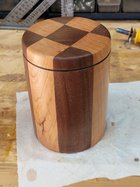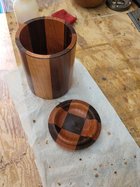-
It's time to cast your vote in the December 2025 Turning Challenge. (click here for details) -
Congratulations to Pat White for "Sicilian Mosaic" being selected as Turning of the Week for December 29, 2025 (click here for details) -
Welcome new registering member. Your username must be your real First and Last name (for example: John Doe). "Screen names" and "handles" are not allowed and your registration will be deleted if you don't use your real name. Also, do not use all caps nor all lower case.
You are using an out of date browser. It may not display this or other websites correctly.
You should upgrade or use an alternative browser.
You should upgrade or use an alternative browser.
Lidded box
- Thread starter Rusty Nesmith
- Start date
-
- Tags
- cherry lidded box walnut
john lucas
AAW Forum Expert
Very nice.
I'll be curious how that lid fits this winter. Some of the growth rings are opposing each other.
Not sure I understand, still fairly new to turning. I glued the nine pieces together. Put it on the lathe and turned it round. Then cut a tenon on both ends. The used a parting tool to cut the top from the bottom. What would be a better way to make it to not have the problem you are talking about?I'll be curious how that lid fits this winter. Some of the growth rings are opposing each other.
Wood always moves. Our wet season is the winter and the summer is the dry season. since the lid and base are identical, you run into the possibility of them moving. You may not be able to spin the lid, but it 'should' still be able to come off. If the lid was different woods from the base, you might not be able to remove the lid. I seldom do boxes over about 1 to 1 1/2 inch diameter for this reason. Lift off lids, not so much of a problem, but threaded boxes, more of a problem.
robo hippy
robo hippy
I've built furniture for 50 years. I know to fit drawers and doors looser in the winter because wood swells across the grain in the summer and shrinks in the winter. I also know you don't glue a frame around a solid wood table top because 3' of wood can shrink or swell over 1/4" over the seasons. When I see laminations, I hope to see all the grain running the same direction so all the wood swells and shrinks together. When I look at the end grain of your lamination, I see growth rings perpendicular to the piece of wood next to it. That means one piece will swell in one direction and the piece next to it swells or shrinks another direction. The pieces aren't big, and movement will be slight, but you could get a crack in the joint when the wood moves. It may also change the fit of the lid with a big humidity change. Wood is not inert, it constantly moves.Not sure I understand, still fairly new to turning. I glued the nine pieces together. Put it on the lathe and turned it round. Then cut a tenon on both ends. The used a parting tool to cut the top from the bottom. What would be a better way to make it to not have the problem you are talking about?
Thanks Richard I understand now. Thanks for the explanation. I will pay attention to that on future builds.
john lucas
AAW Forum Expert
It does get complicated. The problem is wood doesnt move the same in all directions. It moves more across the grain than parallel to the grain. So if you glue an end grain piece to side grain eventually it will.break the glue joint.
Still a really nice looking box!
Great advice for sure...
Great advice for sure...


